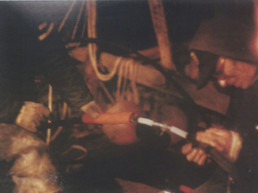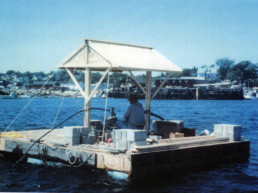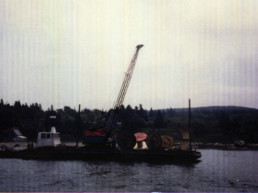The DIY Approach That Linked Isle au Haut to the Grid
Cable has far outlived its life expectancy, thanks to Parker Waite’s problem solving.
By TOM GROENING
Parker Waite moved to Isle au Haut in 1976 “to get off the grid.” Though the phrase may have had as much figurative as literal meaning for him then, today he sees the irony in what occupied much of his time in the years that followed.
Waite was the nuts-and-bolts guy who established the electric cable linking the island with the electric grid. These days, the island is moving toward achieving a measure of independence from that cable, but it’s still operating, having exceeded its life expectancy by a couple of decades.
Before the cable, the island relied on four diesel-fueled generators. The success of that underwater cable is very much tied to the work Waite, now 73, did before the mainland switch could be thrown in 1983.
Waite’s educational background is in the arts, but his approach to bringing mainland electricity seven miles underwater to the island was very much like an engineer’s: gather information, think about site-specific adaptations, and dare to challenge conventional thinking.
Underwater cables connecting to Maine islands are laid either as a continuous cable or spliced as the sections are fed out of the hold of a barge or ship. In the second instance, the ship stops while a splice is made, then continues. Either approach, Waite believed, would mean the cable could be inadvertently strung across ravines and rock piles, which would make it vulnerable to getting hooked by fishing gear, and the cable itself would be subjected to enormous stress while being paied out. Using this method also meant the cable would be under tension; tide or storm current could cause a section lying over a sharp, rocky ledge to wear and break. “I didn’t want to run over any rocky spots,” he said. “It just chafes on the rocks, and I wanted to lay the cable out as gently as possible.”
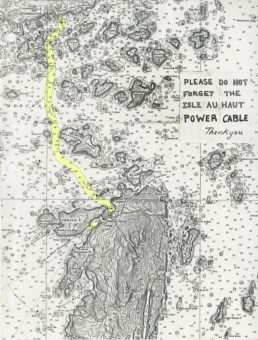
At the time, a new underwater cable had just been installed from Rockland to North Haven by a large cable ship without tug support in a continuous run. It failed before it was turned on. “It didn’t make any sense to do it that way,” Waite said.
As he tried to figure out how to run the wire out safely, he hit upon a fresh idea: instead of paying out the cable in a straight line between mainland and island, he decided “to run it as a snake in a serpentine manner,” in sections of 2,000 feet to 4,000 feet, then make the splices later.
This unconventional idea came from his first-hand knowledge of the underwater landscape. He was a commercial diver who had chased everything from scallops to lost anchors between Mt. Desert Island and Vinalhaven. He had also done work for a repair job on the cable that runs from Swan’s Island to Frenchboro, so he saw up close how cables are damaged and repaired.
“I had crawled the bottom between Stonington and Isle au Haut. With that kind of knowledge, we had a vision of how the bottom looked,” he said. A boat with a fathometer that printed out the contours of the ocean bottom on paper tape supplementing nautical charts also helped. “You literally see it. I could see the gullies and ledges,” he said. “I wanted to go ‘smooth bottom’ as much as possible,” Waite said.
Using lobster buoys by anchoring them with old window sash weights, Waite mapped out the course that made sense. (Having worked as a lobsterman, he knew to first contact local fishermen to explain that he wasn’t encroaching on lobstering turf.)
Waite also investigated the nature of high voltage submarine cables. The industry standard used a metallic armor jacket, but he concluded that made the cable more difficult to handle and likely to fail.
He located a company that made a lightweight submarine cable with a new compound added to the polyethelene insulation which retarded the breakdown of the insulation, another problem leading to cable failure. The product, about an inch-and-a-half in diameter, has proven worthy. “It’s been down there over 30 years now. It’s mind-boggling,” he said.
For the process of laying the cable, Waite sought out local and regional expertise. Locally, he got Charles “Russ” Devereaux, who operated a boatyard in Penobscot, to haul the cable on a “pusher” barge to the site. “He was the go-to marine contractor in this area,” Waite said. After his three years of prep work, Waite superivised Deveraux in running the six cable sections on the bottom from Stonington to Isla au Haut in just over two hours. The ends of each section were secured by rope to buoys awaiting the Boston-based splicer Jim Doucette to arrive in July when the seas were expected to be calm.
Devereaux and Waite built an oversized float/work platfrom with a table covered by an awning for the splicing work to be done on the water. “It’s really surgical,” he said of the exacting process of completing the five splices. “(The splicer) basically took a day to do each splice. He literally shaped every end of every copper wire that was in there,” linking the cable sections strand-to-strand with compression sleeves. A lead sleeve filled with a tar-like substance protected the splice.
The splicer managed the exacting work while he wasn’t feeling his best. “At the end of the first day, he was seasick,” Waite recalled. “And it was what I call flat-ass calm.” Having to focus on close-at-hand work aboard an even slightly rolling platform understandably took its toll.
While much of the cable-laying process went smoothly, Waite did have some close calls.
Once, for instance, Waite gave too much slack to the warp in a splice point in the cable laid in a deep hole between Hardwood and Merchant islands. In the tide the excess slack tangled in a rock pile and tied the cable to the bottom. A 135-foot dive was needed to untangle it with no one on the surface to assist. Normally, if you dive down to 130 feet for 10 minutes or longer, you’d need special equipment for decompressing to get back to the surface. It was equipment Waite didn’t have. He got the job done in about nine minutes.
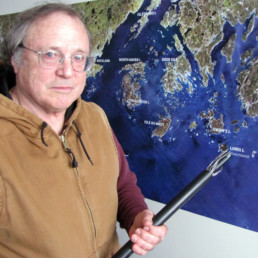
And then, bringing the final splice point on board, Waite accidentally touched the positive and ground conductors at the same time while standing in a puddle of water on the deck. The static electricity that had built up over seven miles coursed through him. “It blew me right off my feet.”
The budget for the cable project was about $110,000, which would be shared by the 50 island ratepayers.
“I charged the company $1.50 an hour,” Waite said. “There was no money.” The cost to ratepayers was computed to be a one-time $1,500 fee. A wealthy summer resident suggested that he and his peers contribute to a fund managed by the church to help those unable to make the payment.
Last summer, sharing his story with islanders, he learned that the church fund had been replenished by locals.
Most of the phone calls in which Waite picked the brains of experts at electric utility companies, suppliers and contractors around the country were made on a “free” pay phone mounted to the exterior wall of the Atlantic Avenue Hardware store in Stonington. Later it became common knowledge that the phone was being tapped by the Federal Drug Enforcement officers responding to smuggling of illegal substances. Users had to enter an access code to get to the free service, but they were also unknowingly being recorded by law enforcement officers.
It’s been more than three decades since the pre-cable installation meetings Waite had with the island power company’s board of directors, when they discussed the potential of then-emerging technologies such as turbines that generated electricity from the wind and tide and photovoltaics that converted sunlight to electricity.
Those technologies have moved from theory to practical application in recent years, but in the late 1970s, it would have been a leap of faith for a small island community to invest in such equipment.
Today, the Isle au Haut Electric Power Company, a for-profit, member-owned cooperative, is pursuing solar power to meet its electricity needs. The plan would start with 486 solar panels while still relying on the cable, then add 954 more panels. Large-scale lithium-ion batteries would store electricity when possible, and a diesel back-up generator would carry the island through the dark months of November to January.
But as that plan takes shape, Waite’s cable remains.
And that guy who moved from Alaska to Isle au Haut to get off the grid, who then was instrumental in linking the island to that grid? “I got my come-uppance,” Waite said.

